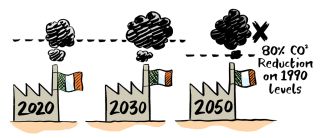Ireland has exceeded 2020 emissions targets

Ireland has exceeded its the EU targets for greenhouse gas emission reductions for 2013-2020 by 12.2 million tonnes of carbon dioxide equivalent according to new projections from the Environmental Protection Agency (EPA) for Ireland’s greenhouse gas emissions for 2020 to 2040. The EPA report provides an updated assessment of Ireland’s total projected greenhouse gas emissions out to 2040 which includes an assessment of progress towards achieving its emission reduction targets out to 2020 and 2030. The main findings of the report are:
Almost 2% per year annual emissions reduction by implementing ‘Additional Measures’
Implementation of “Additional Measures” (including those in the 2019 Climate Action Plan) is projected to save 58 Mt CO2 eq over the period 2021-2030 compared to the “With Existing Measures”. This represents a reduction of 1.8% per annum in emissions over the period.
2020 targets missed
Ireland’s emissions covered by the 2013-2020 EU Effort Sharing Decision target are estimated to have been 7% below 2005 levels in 2020. Ireland is estimated to have cumulatively exceeded its compliance obligations by 12.2 Mt CO2 eq over the 2013- 2020 period, and will need to use credits and/or purchase surplus annual emission allocations from other member states to achieve compliance.
2030 targets require full implementation of the 2019 Climate Action Plan
These Projections indicate that Ireland can meet its non-ETS EU targets over the period 2021 to 2030 assuming full implementation of the 2019 Climate Action Plan and the use of the flexibilities available. Future, more ambitious targets as presented in the European Climate Law and Ireland’s Climate Bill will require many (as yet unidentified) additional measures.
Decarbonising electricity generation
Increased renewable electricity generation, including a projected 5GW of offshore wind generation, is expected to contribute to a 70% contribution of renewable energy in electricity generation by 2030. Energy industries emissions are projected to decrease by one third by 2030 compared to the most recent figures in 2019.
Early action in agriculture
Agriculture emissions are projected to decline by 1.2% per annum over the 2021- 2030 period, provided the 16.5 Mt CO2 eq savings from the agriculture sector identified in the 2019 Climate Action Plan are realised. Increase use of protected urea fertilisers and low emission slurry spreading, along with other measures targeting methane emissions from animals, will be required.
Avoiding post-COVID rebound in transport
The impact of COVID is projected to have led to a 14% reduction in transport emissions in 2020 compared to 2019. The measures in the 2019 Climate Action Plan include 936,000 electric vehicles on the road by 2030 and are projected to reduce emissions to 25.5% below 2019 levels by 2030. It will be necessary to avoid a post- COVID surge in emissions to achieve that reduction.
Energy efficient buildings
The projected impact of COVID in the residential sector in 2020 is an increase of almost 9% in emissions compared to 2019, driven by increased working from home. This highlights the need for our houses to become far more efficient, particularly in the context of broader home working. Implementing the 2019 Climate Action Plan measure for the installation of over 600,000 heat-pumps by 2030 as well as retrofitting 500,000 homes to a B2 equivalent BER will help achieve this.
COVID-19 impact and Green Recovery
A strong impact from COVID is seen in the emissions projections for 2020 and 2021. A decrease of transport emissions and increase in residential emissions are the most obvious effects projected. Agriculture emissions are projected to have been little affected and energy emissions decreases are not primarily COVID related. As the economy exits from COVID restrictions, a “green recovery” where investment is targeted at measures which reduce or avoid greenhouse gas emissions, can result in better outcomes for society and the environment.
Scale of ambition requires immediate action
The scale and pace of the changes needed to achieve the targets set out in the 2019 Climate Action Plan are significant, but the extent of change required to meet the Climate Bill and European Climate Law targets is unprecedented. Further ambitious measures in key sectors such as agriculture, transport and power generation will need to be identified, planned and implemented as soon as possible.
Policies to support reduced emissions
Reducing emissions requires the implementation of policy decisions made in the interest of a sustainable future rather than short-term sectoral interests. While this implementation may be difficult in the initial stages, it will lead to reduced emissions and long-term benefits for all society. This is where our Government and all members of the Oireachtas must show leadership and act in the national interest.
Social Justice Ireland is of the opinion that the following policy proposals that would assist Government delivering on its Green New Deal commitment, reducing emissions and a just transition are:
- Set ambitious emissions reduction targets for 2030 and ensure sufficient resources to support implementation of these targets;
- Adopt targets and a reporting system for each of the Sustainable Development Goals;
- Integrate a Sustainable Development Framework into economic policy;
- Introduce a strategy for Ireland that includes the principles of the circular economy and cradle-to-cradle development;
- Introduce shadow national accounts, and assign value to natural capital and ecosystems in our national accounting systems;
- Develop a comprehensive mitigation and transition programme to support communities and people in the transition to a low carbon society;
- Develop a progressive and equitable environmental taxation system;
- Develop a new National Index of Progress encompassing environmental and social indicators of progress as well as economic ones;
- Develop a Just Transition Dialogue structure at regional and national level.

GIVING A VOICE TO THOSE
WHO DON’T HAVE A VOICE
When you support Social Justice Ireland, you are tackling the causes of problems.
